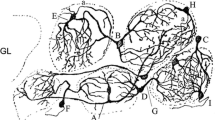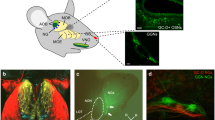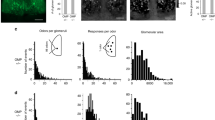Abstract
Each zebrafish olfactory bulb contains ~ 140 glomeruli that are distinguishable based on size, location, neurochemistry and function. Here we examine the mitral cell innervation of differently sized glomeruli in adult zebrafish. Type 1 glomeruli had diameters of 80.9 ± 8.1 μm and were innervated by 5.9 ± 0.9 mitral cells. The Type 1 mediodorsal glomeruli (mdG) were innervated by both uniglomerular (innervating only single glomeruli) and multiglomerular mitral cells (innervating two or more glomeruli). In contrast, the Type 1 ventroposterior (vpG) and lateral glomeruli (lG) were only innervated by uniglomerular mitral cells. Type 2 ventral glomeruli were 46 ± 5.1 μm in diameter and were innervated by 3.3 ± 0.2 mitral cells. Type 2 ventromedial glomeruli (vmG) were innervated exclusively by uniglomerular mitral cells. Type 3 glomeruli had diameters of 17 ± 2.5 μm and were innervated by 1.1 ± 0.6 multiglomerular mitral cells each. Finally, Type 4 glomeruli were small, with average diameters of 4.8 ± 3.9 μm and were restricted to the lateral plexus. These glomeruli were innervated mainly by multiglomerular mitral cells with extensively branching dendrites. This study provides the first specific associations between uni- and multiglomerular mitral cells with known zebrafish glomeruli. Our results suggest that glomeruli are distinguishable based on their postsynaptic compartment and that distinct input–output computations occur in different types of zebrafish glomeruli.







Similar content being viewed by others
Abbreviations
- dG:
-
Dorsal glomerulus
- dlG:
-
Dorsolateral glomerulus
- lG:
-
Lateral glomerulus
- lP:
-
Lateral plexus
- maG:
-
Medial anterior glomerulus
- mdG:
-
Mediodorsal glomerulus
- mpG:
-
Medial posterior glomerulus
- vaG:
-
Ventroanterior glomerulus
- vmG:
-
Ventromedial glomerulus
- vpG:
-
Ventroposterior glomerulus
References
Ahuja G, Ivandic I, Salturk M, Oka Y, Nadler W, Korsching SI (2013) Zebrafish crypt neurons project to a single, identified mediodorsal glomerulus. Sci Rep 3:2063
Alioto TS, Ngai J (2005) The odorant receptor repertoire of teleost fish. BMC Genomics 6:173
Baier H, Korsching S (1994) Olfactory glomeruli in the zebrafish form an invariant pattern and are identifiable across animals. J Neurosci 14:219–230
Biechl D, Tietje K, Ryu S, Grothe B, Gerlach G, Wullimann MF (2017) Identification of accessory olfactory system and medial amygdala in the zebrafish. Sci Rep 7:44295
Braubach OR, Fine A, Croll RP (2012) Distribution and functional organization of glomeruli in the olfactory bulbs of zebrafish (Danio rerio). J Comp Neurol 520:2317–2339, Spc2311
Braubach OR, Miyasaka N, Koide T, Yoshihara Y, Croll RP, Fine A (2013) Experience-dependent versus experience-independent postembryonic development of distinct groups of zebrafish olfactory glomeruli. J Neurosci 33:6905–6916
Byrd CA, Brunjes PC (1995) Organization of the olfactory system in the adult zebrafish: histological, immunohistochemical, and quantitative analysis. J Comp Neurol 358:247–259
Dieris M, Ahuja G, Krishna V, Korsching SI (2017) A single identified glomerulus in the zebrafish olfactory bulb carries the high-affinity response to death-associated odor cadaverine. Sci Rep 7:40892
Dulac C (2000) Sensory coding of pheromone signals in mammals. Curr Opin Neurobiol 10:511–518
Dulac C, Wagner S (2006) Genetic analysis of brain circuits underlying pheromone signaling. Annu Rev Genet 40:449–467
Friedrich RW (2013) Neuronal computations in the olfactory system of zebrafish. Annu Rev Neurosci 36:383–402
Friedrich RW, Korsching SI (1997) Combinatorial and chemotopic odorant coding in the zebrafish olfactory bulb visualized by optical imaging. Neuron 18:737–752
Friedrich RW, Korsching SI (1998) Chemotopic, combinatorial, and noncombinatorial odorant representations in the olfactory bulb revealed using a voltage-sensitive axon tracer. J Neurosci 18:9977–9988
Frontini A, Zaidi AU, Hua H, Wolak TP, Greer CA, Kafitz KW, Li W, Zielinski BS (2003) Glomerular territories in the olfactory bulb from the larval stage of the sea lamprey Petromyzon marinus. J Comp Neurol 465:27–37
Fujita I, Sorensen PW, Stacey NE, Hara TJ (1991) The olfactory system, not the terminal nerve, functions are the primary chemosensory pathway mediating responses to sex-pheromones in male golfish. Brain Behav Evol 38:313–321
Fuller CL, Byrd CA (2005) Ruffed cells identified in the adult zebrafish olfactory bulb. Neurosci Lett 379:190–194
Fuller CL, Yettaw HK, Byrd CA (2006) Mitral cells in the olfactory bulb of adult zebrafish (Danio rerio): morphology and distribution. J Comp Neurol 499:218–230
Gerlach G, Tietje K, Biechl D, Namekawa I, Schalm G, Sulmann A (2019) Behavioural and neuronal basis of olfactory imprinting and kin recognition in larval fish. J Exp Biol 222
Hansen A, Rolen SH, Anderson K, Morita Y, Caprio J, Finger TE (2003) Correlation between olfactory receptor cell type and function in the channel catfish. J Neurosci 23:9328–9339
Hussain A, Saraiva LR, Ferrero DM, Ahuja G, Krishna VS, Liberles SD, Korsching SI (2013) High-affinity olfactory receptor for the death-associated odor cadaverine. Proc Natl Acad Sci U S A 110:19579–19584
Iwahori N, Kiyota E, Nakamura K (1987) A Golgi study on the olfactory bulb in the lamprey, Lampetra japonica. Neurosci Res 5:126–139
Jacobson GA, Rupprecht P, Friedrich RW (2018) Experience-dependent plasticity of odor representations in the telencephalon of zebrafish. Curr Biol 28(1–14):e13
Kermen F, Franco LM, Wyatt C, Yaksi E (2013) Neural circuits mediating olfactory-driven behavior in fish. Front Neural Circuits 7:62
Kermen F, Lal P, Faturos NG, Yaksi E (2020) Interhemispheric connections between olfactory bulbs improve odor detection. PLoS Biol 18:e3000701
Kosaka T, Hama K (1982) Structure of the mitral cell in the olfactory bulb of the goldfish (Carassius auratus). J Comp Neurol 212:365–384
Kress S, Biechl D, Wullimann MF (2015) Combinatorial analysis of calcium-binding proteins in larval and adult zebrafish primary olfactory system identifies differential olfactory bulb glomerular projection fields. Brain Struct Funct 220:1951–1970
Li J, Mack JA, Souren M, Yaksi E, Higashijima S, Mione M, Fetcho JR, Friedrich RW (2005) Early development of functional spatial maps in the zebrafish olfactory bulb. J Neurosci 25:5784–5795
Miyasaka N, Morimoto K, Tsubokawa T, Higashijima S, Okamoto H, Yoshihara Y (2009) From the olfactory bulb to higher brain centers: genetic visualization of secondary olfactory pathways in zebrafish. J Neurosci 29:4756–4767
Munger SD, Lane AP, Zhong H, Leinders-Zufall T, Yau KW, Zufall F, Reed RR (2001) Central role of the CNGA4 channel subunit in Ca2+-calmodulin-dependent odor adaptation. Science 294:2172–2175
Nüsslein-Volhard C, Dahm R (2002) Zebrafish: a practical approach. Oxford University Press, Oxford
Riddle DR, Oakley B (1992) Immunocytochemical identification of primary olfactory afferents in rainbow trout. J Comp Neurol 324:575–589
Sato Y, Miyasaka N, Yoshihara Y (2005) Mutually exclusive glomerular innervation by two distinct types of olfactory sensory neurons revealed in transgenic zebrafish. J Neurosci 25:4889–4897
Scheib JJ, Pozzuto JM, Byrd-Jacobs CA (2019) Reversible deafferentation of the zebrafish olfactory bulb with wax plug insertion. J Neurosci Methods 311:47–56
Shao X, Lakhina V, Dang P, Cheng RP, Marcaccio CL, Raper JA (2017) Olfactory sensory axons target specific protoglomeruli in the olfactory bulb of zebrafish. Neural Dev 12:18
Schmid B, Schindelin J, Cardona A (2010) A high-level 3D visualization API for Java and ImageJ. BMC Bioinformatics 11:1
Stowers L, Logan DW (2010) Olfactory mechanisms of stereotyped behavior: on the scent of specialized circuits. Curr Opin Neurobiol 20:274–280
Wakisaka N, Miyasaka N, Koide T, Masuda M, Hiraki-Kajiyama T, Yoshihara Y (2017) An adenosine receptor for olfaction in fish. Curr Biol 27(1437–1447):e1434
Wanner AA, Genoud C, Friedrich RW (2016) 3-dimensional electron microscopic imaging of the zebrafish olfactory bulb and dense reconstruction of neurons. Sci Data 3:160100
Wanner AA, Genoud C, Masudi T, Siksou L, Friedrich RW (2016) Dense EM-based reconstruction of the interglomerular projectome in the zebrafish olfactory bulb. Nat Neurosci 19:816–825
Weiss L, Jungblut LD, Pozzi AG, Zielinski BS, O’Connell LA, Hassenklover T, Manzini I (2020) Multi-glomerular projection of single olfactory receptor neurons is conserved among amphibians. J Comp Neurol 528:2239–2253
Yabuki Y, Koide T, Miyasaka N, Wakisaka N, Masuda M, Ohkura M, Nakai J, Tsuge K, Tsuchiya S, Sugimoto Y, Yoshihara Y (2016) Olfactory receptor for prostaglandin F2alpha mediates male fish courtship behavior. Nat Neurosci 19:897–904
Acknowledgements
This work was funded by NSERC (Canada Discovery Grant RGPIN-2018–04593) and CIHR (Canada Open Operating Grant INMHA 330,849) and fueled by the Tim Hortons Walnut Crunch. The authors thank Song Ea Beak for her help with the figure preparation.
Funding
This work was funded by NSERC (Canada Discovery Grant RGPIN-2018–04593) and CIHR (Canada Open Operating Grant INMHA 330849).
Author information
Authors and Affiliations
Contributions
OB conceived the experiments; OB conducted the experiments and interpreted the data. OB and RC wrote the manuscript.
Corresponding author
Ethics declarations
Conflict of interest
The authors declare that there is no conflict of interest regarding the publication of this article.
Ethical approval
Experiments adhered to guidelines established by the Canadian animal Council for Animal Care and were approved by the committee for animal care at Dalhousie University.
Additional information
Publisher’s Note
Springer Nature remains neutral with regard to jurisdictional claims in published maps and institutional affiliations.
Supplementary Information
Below is the link to the electronic supplementary material.
Supplementary file2 (MP4 10038 KB)
Supplementary file3 (MP4 14126 KB)
Supplementary file4 (MP4 13072 KB)
Rights and permissions
About this article
Cite this article
Braubach, O., Croll, R.P. The glomerular network of the zebrafish olfactory bulb. Cell Tissue Res 383, 255–271 (2021). https://doi.org/10.1007/s00441-020-03394-4
Received:
Accepted:
Published:
Issue Date:
DOI: https://doi.org/10.1007/s00441-020-03394-4




